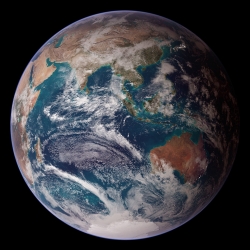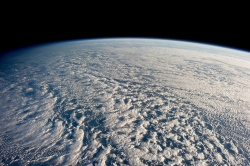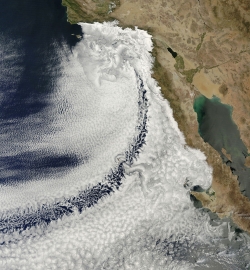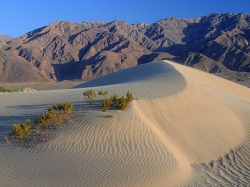At this very moment, it's cool and dry at your house. But on the other side of the world, clouds cover the sky. A storm is coming. As the sun shines down on the Earth, it warms things up. This warmth leads to changes in the sky over your house and around the world. Somewhere it is raining. Somewhere it is shining. Here's why.

From space, the Earth's atmosphere looks like a thin blue line covering the planet.
NASA images by Reto Stöckli, based on data from NASA and NOAA, Public domain, via Wikimedia Commons
The Earth, like most planets, has a warm blanket of gases circling it. This warm blanket traps the sun's heat, making the Earth warm enough for living things. The Earth's strong pull keeps these gases tucked in tight so they cannot get away. The blanket is thicker than you might think, stretching more than 60 miles above the Earth, more like a big fluffy comforter than a thin sheet. The
atmosphere is the name for all the gases that circle the Earth, held in place by Earth's gravity.

Clouds can cover the Earth as far as the eye can see.
ISS Expedition 34 CrewImage Science & Analysis Laboratory, NASA Johnson Space CenterDerivative work including grading, lens profile correction and noise removal.: Julian Herzog, Public domain, via Wikimedia Commons
This blanket of gases is made up of the air you breathe and other stuff like water in the form of gas that makes clouds. Near the ground, the blanket around the Earth is always changing. On a hot summer day near the ocean, there might be more water in the air, making big puffy clouds. As the day goes on, it starts to rain.
Weather is what the atmosphere looks like at one point in time. When we talk about the weather, we talk about what it will be like today or in the next few days.

Watch out for rain along the coast!
NASA image courtesy Jeff Schmaltz, MODIS Rapid Response Team, Public domain, via Wikimedia Commons
Over time, you can probably guess what the weather will be like at your house. Summers may be hot and dry. Winters are cold and rainy or snowy. Or maybe you live near the Earth's middle where it's hot all the time. Every now and then you may get a very dry winter or a cool summer, but the weather is usually the same from year to year.
Climate is the name for the long-term weather patterns in an area over many years. Even though every day might be a little different, we use the climate to help predict what the weather will be like.

It's very dry in the desert. Next water stop somewhere over those mountains.
Jon Sullivan, Public domain, via Wikimedia Commons
Breaking up the year into four different parts helps us describe the weather a few months at a time. The way the Earth tilts as it orbits the sun is responsible for this weather at different times throughout the year. Picture the Earth like a round grape. Now stick a toothpick straight through the center. Circle your grape around a nearby orange. That will be our sun. The imaginary toothpick that goes through the Earth should sit at a slight angle to the orange. That is how the Earth sits, tilting a bit. This tilt means that sometimes some parts of the world are closer to the sun, while other parts are farther away. At any one time, the parts closer to the sun get more sunlight, more light during the day, and more warmth.
Seasons are the four parts of the year -- spring, summer, fall, winter -- that we use to describe how strongly the sun is shining and how much light there is during the day.
The warm blanket of gases around our planet traps the sun's warmth, making it a perfect place for living things. As the sun shines down, it warms the land and water making weather. Still, weather is just a picture in time. We use seasons to talk about weather over a few months. And when we say climate, we are talking about weather over many years. Somewhere it's raining. Somewhere it's shining. Our world, and its weather, is always changing.
References:
"Atmosphere"
Environmental Encyclopedia. Gale, 2011. Science in Context.
<http://ic.galegroup.com/ic/scic/ReferenceDetailsPage/DocumentToolsPortletWindow?displayGroupName=Reference&action=2&catId=&documentId=GALE%7CCV2644150117&source=Bookmark&u=dc_demo&jsid=3771f66e72b125f7ab33923c194d8ed6>
"Weather" National Geographic Education. National
Geographic, 2013.
<http://education.nationalgeographic.com/education/encyclopedia/weather/?ar_a=4>
"Seasons" National Geographic Education. National
Geographic, 2013.
<http://education.nationalgeographic.com/education/encyclopedia/season/?ar_a=4>